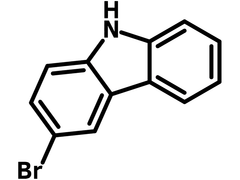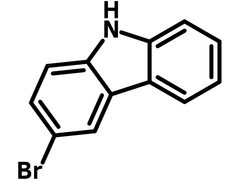3-Bromo-9H-carbazole
CAS Number 1592-95-6
Chemistry Building Blocks, Heterocyclic Building Blocks, Materials, MonomersA popular building block for the synthesis of dopant or host materials
Used in the application of highly efficient phosphorescent and TADF OLEDs.
Specifications | MSDS | Literature and Reviews
3-Bromo-9H-carbazole, CAS number 1592-95-6, is an isomer to 2-Bromo-9H-carbazole with the only difference being that 9H-carbazole is mono-brominated at 3-position. Blocked at 3-position, 3-Bromo-9H-carbazole derivatives reduce the chance of being oxidized to form excimers or oligomers.
Bipolar host material (PBCz-PO) with an electron donating bi-carbazole core joined at 3,3'-postions and an electron accepting phosphine oxide amide unit, possesses a relatively high triplet energy (2.76 eV) which makes it suitable to be blue host in phosphorescent organic light-emitting diodes. The device with PBCz-PO as a host and FIrpic as a dopant achieved a maximum current efficiency (ηc) of 31.5 cd/A, a maximum power efficiency (ηp) of 31.0 lm/W and a maximum external quantum efficiency (EQE) of 13.4% as well as low driving voltage [1]. Device based on 9'-(4-(4,6-diphenyl-1,3,5-triazin-2-yl)phenyl)-9,9''-diphenyl-9H,9'H,9''H-3,3':6',3''-tercarbazole (TCzTrz) as the dopant and DPEPO as the host has also gained high device efficiencies with ηc f 39.4 cd/A, ηp of 61.5 lm/W and a maximum external quantum efficiency (EQE) of 31.8%. The device has the following configuration: ITO (50 nm)/PEDOT:PSS (60 nm)/TAPC (20 nm)/mCP (10 nm)/TCzTrz:DPEPO (10 w%) (25 nm)/TSPO1 (5 nm)/TBPi (20 nm)/LiF (1.5 nm)/Al (200 nm).
3-Bromo-9H-carbazole can be prepared by reacting 9H-carbzole with N-bromosuccinimide (NBS) In tetrahydrofuran at room temperature.
General Information
| CAS Number | 1592-95-6 |
| Chemical Formula | C12H8BrN |
| Full Name | 3-Bromo-9H-carbazole |
| Molecular Weight | 246.1 g/mol |
| Synonyms | 3-Bromocarbazole |
| Classification / Family | Carbazoles, semiconductor synthesis intermediates, Electron donor unit, OLED, OFETs, organic photovoltaics |
Chemical Structure

Product Details
| Purity | >98% (1H NMR) |
| Melting Point | 198 °C |
| Appearance | White to off-white powder/crystals |
MSDS Documentation
3-Bromo-9H-carbazole MSDS Sheet
Literature and Reviews
- A host material consisting of phosphinic amide for efficient sky-blue phosphorescent organic light-emitting diodes, F, Wu et al., Synth. Met., 205, 11-17 (2015); DOI: 10.1016/j.synthmet.2015.03.023.
- Carbazole or carbazole-3-carbonitrile /pyridine host materials for efficient solution-processable blue phosphorescent and green TADF OLEDs, C. Tang et al., Opt. Mater., 132, 112573 (2022); DOI: 10.1016/j.optmat.2022.112573.
- Carbazole-Based Hole-Transport Materials for High-Efficiency and Stable Perovskite Solar Cells, L. Gao et al., ACS Appl. Energy Mater., 3, 5, 4492–4498 (2020); DOI: 10.1021/acsaem.0c00179.
